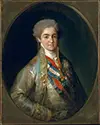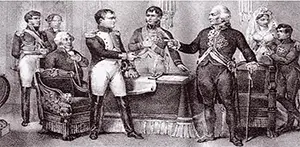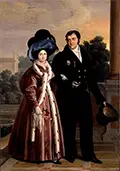King Ferdinand VII of Spain
Ferdinand VII was King of Spain for more than two decades during the 19th Century. 
He was born on Oct. 14, 1784, at the royal palace in Madrid. His father was the reigning monarch, Charles IV, and his mother was Maria Luisa of Parma. Ferdinand was his parents' oldest son and so was the heir apparent to the Spanish throne. Charles much preferred the joys of hunting and the outdoors. When he became King of Spain, he carried over his father's advisors and left the running of the country largely to them and to his wife, who had a very powerful personality and enjoyed enormous influence over her husband, in their home life and in their public life, including in his reign. Thus, Ferdinand received basic education training but no instruction in the ways of government. Charles retained the Count of Floridablanca as Chief Minister. That statesman served in that position for four years, until internal politics led to his ouster, in favor of first the Count of Aranda and then Manuel de Godoy, the favorite of Queen Maria Luisa. Godoy it was who guided Spain into an alliance with other powers against Revolutionary France in the War of the First Coalition. Charles had spoken out publicly against the execution of France's King Louis XVI, and France had declared war on Spain in 1793. Spanish troops advanced through the Pyrenees and had success for a time. A French invasion of Spain in 1794 convinced Charles and Godoy to sue for peace. In 1795, France and Spain agreed to stop fighting each other. In 1802, Ferdinand married his first cousin Princess Maria Antonia of Naples and Sicily; the couple had no children, and she died in 1806. Godoy again chose to ally with France, in 1808. That provoked a public uprising throughout the Spain. By this time, Ferdinand, now 24, had had enough of his father's not really running the kingdom and stepped in to depose him. Ferdinand had gained widespread support for his plan to replace his father (spurring a movement of people who referred to themselves as fernandistas), and Charles IV abdicated the throne on March 19, 1808. King Ferdinand VII then ruled Spain. 
He was king for all of three months, however, because the power behind the throne was really the French emperor, Napoleon Bonaparte, who summoned both Charles and Ferdinand to a meeting at the French location of Bayonne in April 1808. At that meeting, Bonaparte forced Ferdinand to abdicate and prevented Charles from retaking the throne, giving it instead to Joseph Bonaparte, the emperor's brother. This began the Peninsular War. Napoleon Bonaparte kept Ferdinand under guard at a château in Valençay for six years. During that time, the fortunes of Bonaparte ebbed and flowed, as did French successes in the Peninsular War. In 1813, Bonaparte agreed to give the throne back to Ferdinand. 
He began as King of Spain again on Dec. 11, 1813, after agreeing to abide by the terms of a constitution that the Spanish people had passed during his absence. It didn't take him long to break that promise. In May 1814, Ferdinand renounced the constitution, declared himself an absolute monarch, and ordered the architects of the constitution arrested as enemies of the crown. At the same time, however, revolts against Spanish rule began in the New World. These intensified during the Peninsular War, as people in North America and South America found themselves emboldened to consider independence while Spanish armies and navies were so desperately involved in what amounted to an Iberian Peninsula civil war. Ferdinand married again in 1816, to Maria Isabel of Portugal. She lived two years more, and the couple had no surviving children. Ferdinand's third wife was Princess Maria Josepha Amalia of Saxony; they were married for a decade (1819–1829) and had no children. In Spain itself, a mutiny of troops in 1820 sparked a wider revolt that succeeded in taking King Ferdinand prisoner. Thus distracted, the king could only receive reports from abroad as one by one of his overseas possessions gained their freedom. Ferdinand was technically still king, but his people had taken away his mystique and, technically, his right to dictate terms. The following year, an 11-year insurgency led by soldiers, religious leaders, and the general population ended in the independence of Mexico. Other liberations soon followed, including those led by Simón Bolívar.
Into Spain's internal fray in 1823 came a French army, sent by that country's king, Louis XVIII, to try to restore Ferdinand's absolutism. He and they were successful, the rebel force releasing the king after the French victory in the Battle of Trocadero. In 1829, Ferdinand married again, to Maria Christina of the Two Sicilies. They had two daughters, María Isabel and Maria Luisa, both of whom survived into adulthood. In fact, María Isabel succeeded her father as the reigning monarch of Spain. In his last days, Ferdinand had removed the Salic Law prohibition against a woman's inheriting a throne. Ferdinand died on Sept. 18, 1833. That same day saw the recognition of Spain's Queen Isabella II. |
|
Social Studies for Kids
copyright 2002–2024
David White





